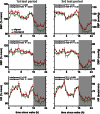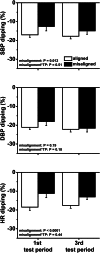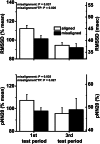Circadian misalignment increases cardiovascular disease risk factors in humans
- PMID: 26858430
- PMCID: PMC4790999
- DOI: 10.1073/pnas.1516953113
Circadian misalignment increases cardiovascular disease risk factors in humans
Abstract
Shift work is a risk factor for hypertension, inflammation, and cardiovascular disease. This increased risk cannot be fully explained by classic risk factors. One of the key features of shift workers is that their behavioral and environmental cycles are typically misaligned relative to their endogenous circadian system. However, there is little information on the impact of acute circadian misalignment on cardiovascular disease risk in humans. Here we show-by using two 8-d laboratory protocols-that short-term circadian misalignment (12-h inverted behavioral and environmental cycles for three days) adversely affects cardiovascular risk factors in healthy adults. Circadian misalignment increased 24-h systolic blood pressure (SBP) and diastolic blood pressure (DBP) by 3.0 mmHg and 1.5 mmHg, respectively. These results were primarily explained by an increase in blood pressure during sleep opportunities (SBP, +5.6 mmHg; DBP, +1.9 mmHg) and, to a lesser extent, by raised blood pressure during wake periods (SBP, +1.6 mmHg; DBP, +1.4 mmHg). Circadian misalignment decreased wake cardiac vagal modulation by 8-15%, as determined by heart rate variability analysis, and decreased 24-h urinary epinephrine excretion rate by 7%, without a significant effect on 24-h urinary norepinephrine excretion rate. Circadian misalignment increased 24-h serum interleukin-6, C-reactive protein, resistin, and tumor necrosis factor-α levels by 3-29%. We demonstrate that circadian misalignment per se increases blood pressure and inflammatory markers. Our findings may help explain why shift work increases hypertension, inflammation, and cardiovascular disease risk.
Keywords: circadian misalignment; hypertension; inflammatory markers; night work; shift work.
Conflict of interest statement
The authors declare no conflict of interest.
Figures









Comment in
-
Beating against the clock.Proc Natl Acad Sci U S A. 2016 Mar 8;113(10):2558-9. doi: 10.1073/pnas.1601161113. Epub 2016 Feb 23. Proc Natl Acad Sci U S A. 2016. PMID: 26908876 Free PMC article. No abstract available.
Similar articles
-
Circadian Misalignment Increases C-Reactive Protein and Blood Pressure in Chronic Shift Workers.J Biol Rhythms. 2017 Apr;32(2):154-164. doi: 10.1177/0748730417697537. Epub 2017 Mar 27. J Biol Rhythms. 2017. PMID: 28347188 Free PMC article.
-
Effects of the Internal Circadian System and Circadian Misalignment on Glucose Tolerance in Chronic Shift Workers.J Clin Endocrinol Metab. 2016 Mar;101(3):1066-74. doi: 10.1210/jc.2015-3924. Epub 2016 Jan 15. J Clin Endocrinol Metab. 2016. PMID: 26771705 Free PMC article. Clinical Trial.
-
Influence of sleep deprivation and circadian misalignment on cortisol, inflammatory markers, and cytokine balance.Brain Behav Immun. 2015 Jul;47:24-34. doi: 10.1016/j.bbi.2015.01.004. Epub 2015 Jan 29. Brain Behav Immun. 2015. PMID: 25640603 Free PMC article.
-
Impacts of shift work on sleep and circadian rhythms.Pathol Biol (Paris). 2014 Oct;62(5):292-301. doi: 10.1016/j.patbio.2014.08.001. Epub 2014 Sep 20. Pathol Biol (Paris). 2014. PMID: 25246026 Review.
-
Shift work and cardiovascular risk factors: new knowledge from the past decade.Arch Cardiovasc Dis. 2011 Dec;104(12):636-68. doi: 10.1016/j.acvd.2011.09.004. Epub 2011 Nov 21. Arch Cardiovasc Dis. 2011. PMID: 22152516 Review.
Cited by
-
Objective Assessment of Daytime Napping and Incident Heart Failure in 1140 Community-Dwelling Older Adults: A Prospective, Observational Cohort Study.J Am Heart Assoc. 2021 Jun 15;10(12):e019037. doi: 10.1161/JAHA.120.019037. Epub 2021 Jun 2. J Am Heart Assoc. 2021. PMID: 34075783 Free PMC article.
-
Proceedings of the Sleep and Epilepsy Workgroup: Section 2 Comorbidities: Sleep Related Comorbidities of Epilepsy.Epilepsy Curr. 2021 Apr 12;21(3):15357597211004549. doi: 10.1177/15357597211004549. Online ahead of print. Epilepsy Curr. 2021. PMID: 33843327 Free PMC article.
-
When the clock ticks wrong with COVID-19.Clin Transl Med. 2022 Nov;12(11):e949. doi: 10.1002/ctm2.949. Clin Transl Med. 2022. PMID: 36394205 Free PMC article. Review.
-
Circadian rhythm disorder: a potential inducer of vascular calcification?J Physiol Biochem. 2020 Nov;76(4):513-524. doi: 10.1007/s13105-020-00767-9. Epub 2020 Sep 18. J Physiol Biochem. 2020. PMID: 32945991 Review.
-
Apneic Sleep, Insufficient Sleep, and Hypertension.Hypertension. 2019 Apr;73(4):744-756. doi: 10.1161/HYPERTENSIONAHA.118.11780. Hypertension. 2019. PMID: 30776972 Free PMC article. Review. No abstract available.
References
-
- Bureau of Labor Statistics US . Workers on Flexible and Shift Schedules in May 2004. US Department of Labor; Washington, DC: 2005.
-
- Lieu SJ, Curhan GC, Schernhammer ES, Forman JP. Rotating night shift work and disparate hypertension risk in African-Americans. J Hypertens. 2012;30(1):61–66. - PubMed
-
- Sakata K, et al. The relationship between shift work and the onset of hypertension in male Japanese workers. J Occup Environ Med. 2003;45(9):1002–1006. - PubMed
-
- Morikawa Y, et al. Relationship between shift work and onset of hypertension in a cohort of manual workers. Scand J Work Environ Health. 1999;25(2):100–104. - PubMed
Publication types
MeSH terms
Substances
Grants and funding
LinkOut - more resources
Full Text Sources
Other Literature Sources
Medical
Research Materials

